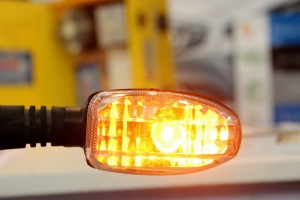Text: Anusha B
Kwality Photonics, India’s largest producer of Light Emitting Diodes (LEDs) foresees a huge potential in LEDs. But the cognizance on the same is still not rooted in the minds of many but soon it is expected to hit the market with big bash. China is a performing player in the LED market where India could equal them with the technology they adapt and play a quality game with a equal potential. But the quantity-play with them is ineffable as they have capacity to cater voluminous business of any mass and scale.
Underlining the joint venture Vijay Kumar, Director, Kwality Photonics opined that, “If we make a joint venture with chinese companies, we could scale-up the awareness of LEDs in the Indian markets too with volume-renders and the efficiency of our built-up would also increase. This could also be done with US companies but the cost part should be considered. Working on the optimisation rule, we conclude the JV shapes up well with Chinese majors for our markets.”
Established in 1987, Kwality Photonics a technology leader due to its legacy in LED manufacturing technology. Kwality Electricals is another establishment which comes under the Kwality Group which is elder than Kwality Photonics supplied all automotive bulbs except the General Lighting Service (GLS) bulbs to component suppliers and OEMSs. As the technology becomes obsolete, the Kwality Electricals started now rallying in the track of solar based bulb products. Kwality Photonics, the LED maker with its technology strength offers more than 600 LED variants, LED displays and opto electronic products at affordable prices. Commenting on the LED furnish in the cars Kumar remarked that, “Lot of car interior lights are getting replaced now with LED lights. The filament based cabin lights, roof lights and other interior lights are LED driven now in most of the cars and the exterior based lights are getting standardised and soon this will also be LED driven. Initially we supplied filament based bulbs to TVS Group from Kwality Electricals but now we are not connected directly with OEMs.”
Our LED bulbs are embellishing the Maruti segment through component suppliers now and we also supply to Minda group and in turn they supply to OEMs added Kumar. LED lights are very useful and energy saving; 10 times more than the filament bulbs. Filament bulbs will emit 97% heat and 3% light whereas the LED emits one-third of light and two-thirds of heat which figures out as 65% heat and 35% light.
In auto industries with the use of LEDs power consumption will be very low and when we compass our review in price angle, the economies of scale would be achieved through mass production. The form factor of LED is just the replica of filament bulbs and could very well befit the needs of the OEMs and the luminescence grades well than the filament bulbs. The reason behind the snailing in adoption of LEDs is the lack of formulation of standards which normally has to be done prior to embracing any inventions. “If standards are formulated for the usage of LED based bulbs (which emits same form factor and exceeding the luminescence when compared to filament bulbs) very quickly the LED bulbs will lighten our roads,” stated Kumar.
Almost all cars are fitted with LED lights in their tail lights and brake lights. LED lights are compatible for all segments and is not manufactured separately for different models so as for two-wheelers. The response time is ultrafast with the lag time almost nullified. For instance a filament bulb takes 100 milliseconds to blow when brakes are applied whereas the LED blows instantly. This is one of the safety features which is highlighted with regards to LED. From the beginning, there are 3 models which use LEDs viz Audi, Toyota and Mercedes Benz. Now LED-needs and merits are widely getting accepted and Maruti’s recent launches and Honda’s launches are LED driven. “Our foray into auto industries is dramatic wherein LED chips are produced here and and the chips are being sent to component suppliers. They take care of clustering and the final LED chip, bulb and the cap are assembled together and supplied to OEMs. We have an unique tail lamp variant which is named as ‘Proleds’ and the same product is in the test marketing phase. ‘Unileds’ is another LED which is getting exported to Middle-East and it is awaiting patent.”
LEDs are getting popularised incrementally as they do have solutions for all issues and they are environmentally safer. Unlike filament bulbs LEDs do not have mercury which could possibly cause pollution in the environment. LEDs equally serve the purpose of filament bulbs with lots of value additions; exhibiting the attributes like energy efficient and eco friendliness. The efficiency is quantified as 80 lumens/watt for filament bulbs and 200 lumens/watt in case of LEDs. Long life, higher efficiency and pollution-free environment is possible with the adoption of LEDs. LED’s significance is demonstrated with the fact that the Nobel prize is conferred to 3 persons who were in research for 30 years on LEDs and invented blue LEDs in 2014.
“Our R&D centre is manned with 10-15 professionals who consistently work on new inventions. We normally invest 5-6% of our revenue as R&D expenditure. The capacity utilisation is currently 80% and we have 3 lines in Hyderabad which outputs 100 million LEDs per annum. We do not have plans for capacity expansion but with very good awareness in place and standards being formulated, the business will call for capacity expansion. As of now we export our automotive LEDs only to Middle-East and our exports comprise 10% of the production volume. The growth is commendable and we secured 200% growth against the previous year and the same will increase exponentially with all the measures in place concluded Kumar.













Leave a Reply